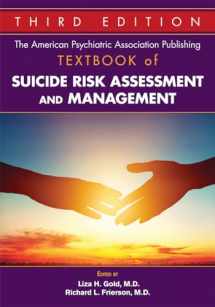
The American Psychiatric Association Publishing Textbook of Suicide Risk Assessment and Management
Book details
Summary
Description
Charged with updating the preeminent text on suicide, the new editors of The American Psychiatric Association Publishing Textbook of Suicide Risk Assessment and Management opted not to simply revise existing chapters, but instead to steer a bold course, expanding, reconfiguring, and remaking the third edition to reflect the latest research, nomenclature, and clinical innovations. The editorial team and contributors -- two-thirds of whom are new to this edition -- have taken the intersection of suicide with both mental health and psychosocial issues as their organizing principle, exploring risk assessment and epidemiology in special populations, such as elderly patients, college students, military personnel, and the incarcerated as well as patients with a variety of psychological disorders, including bipolar spectrum, personality, depressive, anxiety, posttraumatic stress, and other disorders and schizophrenia. In addition, the book discusses treatment options (such as cognitive-behavioral therapy, dialectical behavioral therapy, and pharmacotherapy) and settings (such as emergency services, outpatient, inpatient, and civil commitment) in detail, with clinical cases to contextualize the material.
The new and revised content is extensive: A chapter on the influence of sleep and sleep disorders on suicide risk has been included that considers possible mechanisms for this link and discusses practical ways of assessing and managing sleep disorders to mitigate suicide risk. Nonsuicidal self-injury, the prevalence of which is particularly high among youth, is addressed in detail, differentiating it from and comparing it to suicide attempts, discussing risk assessment, considering safety interventions, examining treatment options, and exploring suicide contagion. No text on suicide would be complete without a serious exploration of the role of social media and the internet. The book presents an update on current research as it pertains to social networking and behavior, information access, and artificial intelligence and software, and includes suggestions for clinicians treating patients at risk for suicide. Physician-assisted dying (PAD), also referred to as "aid-in-dying," is arguably a form of suicide, and the book includes a thoughtful chapter considering the ethical and practical implications of PAD, the murky professional and legal obligations that may arise, the demographics of these patients, the settings and conditions under which PAD may occur, and the role of the attendant clinicians. A number of pedagogical features are included to help the reader learn and remember the material, including key clinical concepts and abundant case examples. Its diverse range of perspectives, broad relevance to a wide variety of clinicians, and absolutely authoritative coverage makes this new edition of The American Psychiatric Association Publishing Textbook of Suicide Risk Assessment and Management a worthy and indispensable successor.


We would LOVE it if you could help us and other readers by reviewing the book
Book review



